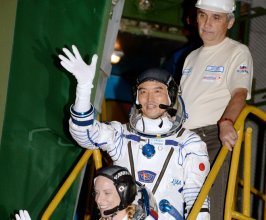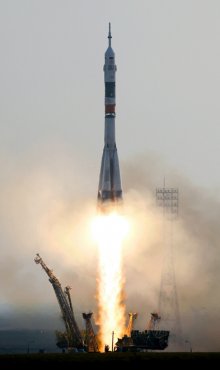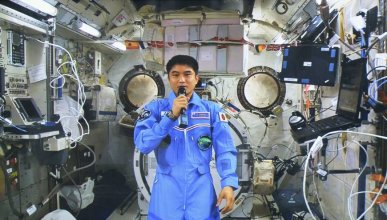
BAIKONUR, Kazakhstan--The Japanese Star Festival was July 7 so, respecting tradition, astronaut Takuya Onishi penned his high hopes for his mission before blasting off into space.
Onishi said that he and his two shipmates wrote down their wishes for a successful mission on sheets of “tanzaku” paper, as done in Japan during the annual festival, which is called "Tanabata."
The Russian Soyuz spacecraft carrying Onishi, cosmonaut Anatoly Ivanishin and U.S. astronaut Kathleen Rubins lifted off from Baikonur Cosmodrome at 7:36 a.m. on the festival day and headed for the International Space Station, which will be the home of the team for the next four months.
The space pod carrying the three crew members successfully separated from the launch vehicle nine minutes into their flight at an altitude of about 200 kilometers. The space staffers were seen cheering their successful launch inside the pod.
“We want to make the flight carrying the hopes and dreams of people around the world and across Japan,” Onishi, 40, said in a news conference held at the space center the day before blast-off.
He was speaking through glass windows to minimize the risk of infection for the crew.
STARMAN
Onishi became infatuated with the heavens when his father took him to see one of the “Star Wars” movies when he was in second-grade.
His fascination toward the skies went full speed ahead after that and he submitted a report titled “Upon Closely Studying Stars and Constellations” for a school project when he was a first-year junior high school student.
In the report, he explained what black holes are and also how to locate constellations. He concluded that “stars were something I gazed at without thought, but they were very interesting when I looked into them more.”
But Onishi said that for a long time being an astronaut was “a dream that I never thought would come true.”
With his passion for space flowing strongly inside him, he decided to become a pilot by enrolling in the University of Tokyo’s Department of Aeronautics and Astronautics. After graduation, he joined All Nippon Airways Co.
After working with the airline for about five years as a copilot, Onishi learned that the Japan Aerospace Exploration Agency (JAXA) was looking for candidate astronauts. He decided to give it a shot and ultimately became one of the three from 963 applicants who qualified for the program.
If all goes according to plan, Onishi’s spacecraft will rendezvous with the space station orbiting some 400 kilometers above Earth about 50 hours into the flight.
The Soyuz flight to the ISS last July of Kimiya Yui--the last Japanese astronaut to stay on the space station before Onishi--took only six hours. The latest journey is a much lengthier one because the crew is tasked with testing out a new type of Soyuz spacecraft that must orbit around Earth 34 times.
The main mission for the astronauts will take place on the ISS. Onishi is scheduled to perform 20 or so experiments and observations, including the handling of mice and synthesizing high quality proteins in a zero-G environment.
JAXA's unmanned H-II Transfer Vehicle, also known as Konotori, is scheduled to deliver Japanese-made lithium-ion batteries and other supplies to the ISS in the fall. Onishi could be the crew member operating the robotic arm on the ISS to enable the pod to dock.
Onishi is the sixth Japanese astronaut to embark on a long-term ISS mission.




